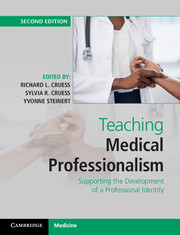Book contents
- Frontmatter
- Contents
- List of contributors
- Foreword
- Introduction
- Part I What is to be taught and learned
- Part II Theory
- 3 Theoretical insights into the nature and nurture of professional identities
- 4 Socialization, professionalism, and professional identity formation
- 5 Educational theory and strategies to support professionalism and professional identity formation
- 6 Role modeling and mentoring in the formation of professional identity
- 7 Experiential learning and reflection to support professionalism and professional identity formation
- Part III Principles
- Part IV Case studies in promoting professionalism and professional identity formation across the continuum
- Part V The future
- Index
- References
3 - Theoretical insights into the nature and nurture of professional identities
from Part II - Theory
Published online by Cambridge University Press: 05 April 2016
- Frontmatter
- Contents
- List of contributors
- Foreword
- Introduction
- Part I What is to be taught and learned
- Part II Theory
- 3 Theoretical insights into the nature and nurture of professional identities
- 4 Socialization, professionalism, and professional identity formation
- 5 Educational theory and strategies to support professionalism and professional identity formation
- 6 Role modeling and mentoring in the formation of professional identity
- 7 Experiential learning and reflection to support professionalism and professional identity formation
- Part III Principles
- Part IV Case studies in promoting professionalism and professional identity formation across the continuum
- Part V The future
- Index
- References
Summary
Introduction
The formation of identities is a process. Our own particular identities enable us to understand our place in the world: in other words, identities enable us to identify others and ourselves in any particular context. Furthermore, identity is not a singular, unchanging entity that we possess. Rather, it is a multifaceted and highly subjective concept that, influenced by many environmental factors, evolves over time and is enacted through language and objects in the social world.1,2 Likewise, medical professionalism is contextual and evolving and is conceptualized according to a number of different discourses.3,4 These discourses identify professionalism as an attribute of the individual physician, the interactional exchange, and the wider organizational and social context within which it occurs. Again, professionalism has a temporal aspect, rather than being a static and fixed concept. I will outline a range of theoretical underpinnings for the concept of professional identities that seek to explain its nature (i.e., internal cognitive processes) and its nurture (i.e., external social processes). My aim is to simplify, synergize, and contextualize the often complex, conflicting, and abstract notions of identity, identities, and identification in order to inform the ways in which we might consider the nature and nurture of professional identities in our explicit education of professionals. Furthermore, many of the theoretical approaches to identity, and the subsequent research within these approaches, tend to classify individuals into particular types. By way of a caveat, I am mindful that, while these are useful classifications for understanding the diverse nature and nurture of professional identities, the stereotyping of people according to such classifications is problematic. Although classifications can be positive or negative, they necessarily overlook the complexity of individuals, and as such are neither true nor false.
Identities and social worlds
Before we begin to think about professional identities, it is useful for us to stand back and consider the broader issue of how we conceptualize the human world within which identities and professionalism emerge, along with the process through which identities are developed. Irrespective of our broader cultural environment, we are all, to some extent, both embodied individuals and part of collective worlds, or cultures (e.g., familial, friendship, organizational, national).
- Type
- Chapter
- Information
- Teaching Medical ProfessionalismSupporting the Development of a Professional Identity, pp. 37 - 53Publisher: Cambridge University PressPrint publication year: 2016
References
- 25
- Cited by



